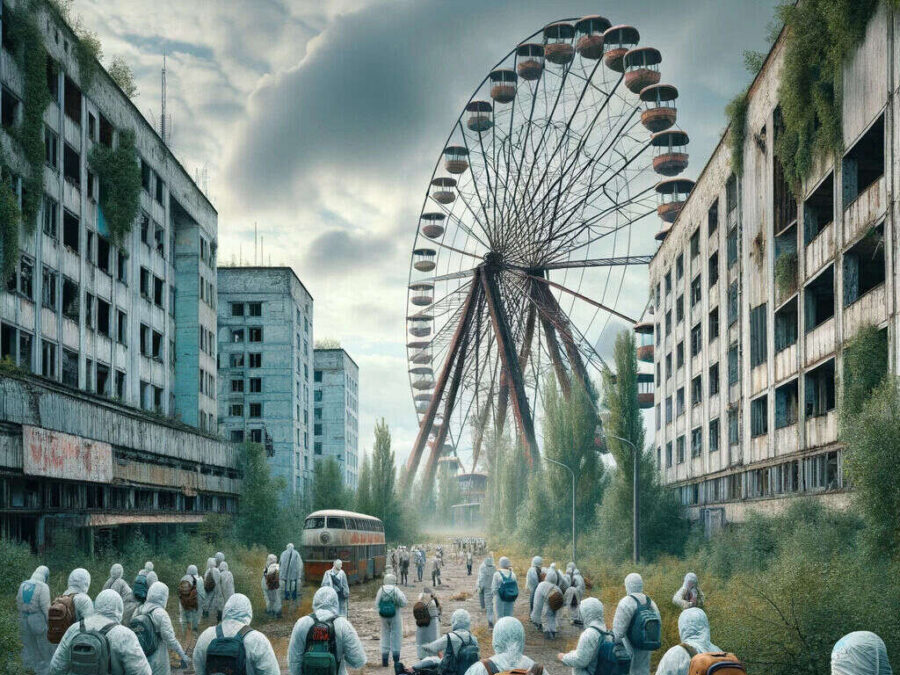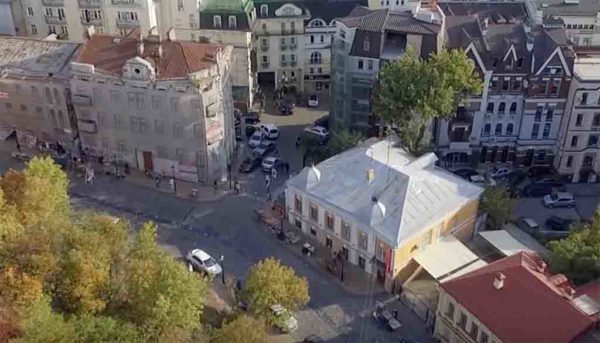When visiting Ukraine, you have the unique opportunity to take a tour of Chernobyl, the site of the infamous 1986 nuclear disaster. This tour offers a profound glimpse into a pivotal moment in history, allowing visitors to see the once-bustling area that’s now an eerie, abandoned zone.
Despite the passage of time, Chernobyl remains a symbol of the catastrophic potential of nuclear accidents, making this tour an unforgettable experience that intertwines history, tragedy, and the resilience of nature.
What Happened?
On April 26, 1986, during a system test at the Chernobyl Power Plant in Pripyat, Ukraine, a significant power surge occurred. This led to an explosion and meltdown in reactor No. 4, resulting in a major fire.
The incident caused widespread radioactive contamination across large regions of Europe and the Soviet Union, emitting radiation levels over 200 times greater than those from the bombings of Hiroshima and Nagasaki. Approximately 600,000 to 800,000 individuals from Ukraine and the Soviet Union collaborated in the extensive cleanup efforts, which included extinguishing the fire and decontaminating homes and equipment.
This process spanned over two years. In the aftermath, around 350,000 people were displaced, and the lives of 7 million were impacted.
Despite the 1986 disaster, the power plant continued operating its remaining three reactors, eventually shutting down each for various reasons. The plant stopped generating electricity in December 2000.
For a complete list of current companies offering tours, I’d recommend visiting this TripAdvisor page.
Inside the Chernobyl Exclusion Zone (Video)
Chernobyl Power Plant
The Chernobyl Power Plant disaster, known for its significant radioactive fallout, has paradoxically become a destination for urban explorers and those intrigued by its history. Tours of Chernobyl are legally permitted and conducted under strict guidelines to ensure safety.
Participants in these guided or group tours have the opportunity to safely navigate the ruins of the plant and its environs, capturing photographs and creating unforgettable experiences.
Safety is a top priority, with tours meticulously avoiding the few areas that still exhibit high radiation levels. The sight of the power plant, now being reclaimed by nature, offers a unique and compelling spectacle.
Secret Duga Radar
In Chernobyl, beyond the infamous power plant, there are various other intriguing sites to explore. Tours in the area often include a visit to the Duga Radar array. This colossal structure was a part of the Soviet missile defense system, operational between 1976 and 1989.
The Duga towers loom over the landscape, once broadcasting high-frequency signals. These transmissions not only interfered with radio communications but also produced a persistent, high-pitched sound, leading to its nickname, the “Russian Woodpecker.”
Initially, the purpose of these signals was shrouded in mystery, sparking local speculation about their intent, with theories ranging from submarine communications to more covert operations. Eventually, the true function of the radar was revealed, but the towering structures remain as a testament to their time.
Pripyat Ghost Town
Located near the Chernobyl Power Plant is the abandoned town of Pripyat, which stands as a ghostly relic of the 1986 disaster. Established in 1970, Pripyat was originally built to house the employees of the power plant and their families, growing to accommodate nearly 50,000 residents.
Despite its primary role as a support town for the power plant, Pripyat was a fully functional city, complete with schools, apartment buildings, stores, and even a movie theater. Following the disaster, the town was swiftly evacuated, leaving these structures to decay over time, now awaiting visitors to witness their eerie stillness.
New Safe Confinement
In the aftermath of the Chernobyl Power Plant meltdown, extensive cleanup efforts were necessary. The damaged reactor No. 4 was initially encased in a structure known as a “sarcophagus.” However, over time, this enclosure experienced some deterioration due to the persistent high radiation levels and lack of maintenance.
To address this, in 2010, work began on the New Safe Confinement for reactor No. 4. This modern structure is engineered to contain the radioactive remnants of the reactor and mitigate further environmental contamination for the next century.
A collaborative international effort, involving various companies from different countries, was pivotal in the design and construction of this containment system. The New Safe Confinement, a significant undertaking, aimed to safeguard the surrounding areas from ongoing radiation exposure.
Chernobyl Riverport
The region surrounding the Chernobyl Power Plant is characterized by its abundant natural water features, including rivers, marshes, and lakes. Notably, both the city of Pripyat and the Chernobyl Power Plant are situated on the banks of the Pripyat River. The nuclear fallout from the Chernobyl disaster had a significant impact on these waterways, leading to extensive radiation contamination.
This has rendered the waters in the area unsafe for consumption and use by both humans and wildlife. Following the evacuation of people, the local wildlife, including animals like catfish, remained in the area.
There have been observations of unusually large catfish in these waters, which has drawn the attention of tourists and scientists, highlighting the profound effects of radiation on living organisms.
Pripyat Cargoport
The Pripyat Cargoport, in the vicinity of the Chernobyl Power Plant, presents a poignant sight of abandonment. This site, which was once a bustling cargo port, is now characterized by its rusting infrastructure and machinery. A prominent feature of this desolate landscape is a large, claw-like crane, looming over the area.
This relic of industry serves as a stark reminder to visitors of the city’s past – a time when it was a hub of trade and commerce before being abruptly abandoned in the wake of the disaster. The Cargo port stands as a symbol of the thriving community that once existed here, now lost to the aftermath of the Chernobyl incident.
Buried Village
Located to the south of the Chernobyl Power Plant was the small village of Kopachi. In the aftermath of the Chernobyl disaster, the entire population was evacuated, and an unusual experiment was conducted: almost the entire village was buried as a method to manage radioactive contamination. Today, only a schoolhouse and another brick building remain standing amidst this landscape.
Numerous mounds now mark the area, each representing the buried remains of the village’s houses. Atop each mound, a sign displaying the radiation symbol serves as a stark reminder of the tragedy that unfolded here. Kopachi is unique in the exclusion zone for being the only village subjected to this method of containment.
Red Forest
The Red Forest, encompassing an area of 10 square kilometers, stands as one of the most radioactively contaminated locations on Earth, severely impacted by the Chernobyl disaster. The name “Red Forest” was derived from the eerie transformation of the trees, which turned a reddish color as they died from the high levels of radiation.
In an effort to mitigate the radiation, much of this forest was subsequently bulldozed, and the contaminated waste buried. Interestingly, despite the dangerous radiation levels, the natural ecosystem in and around the area has shown remarkable resilience. A variety of wildlife has taken refuge in this region, thriving in the absence of human habitation.
Soviet Command Center
Following the Chernobyl Power Plant disaster, the command center of the enigmatic Duga Radar was abandoned, leaving behind a fascinating glimpse into the past. The rooms of this command center remain in a state of disrepair, covered in dust, frozen in time.
Visitors to the site can discover remnants of Soviet-era life scattered throughout, such as posters and paperwork, offering a unique insight into the daily life and secretive work culture of Soviet employees. This site provides a rare opportunity for tourists in Chernobyl to explore an intriguing aspect of history, unveiling a part of the Soviet Union’s once-hidden world.
Pripyat Fairground
The Pripyat Amusement Park, located near the Chernobyl Power Plant, is one of the most eerily captivating sites affected by the disaster. This park was originally set to open on May 1, 1986, but the tragic events at the power plant precluded its inauguration. As a result, attractions like bumper cars, a Ferris wheel, and swing boats were abandoned, gradually succumbing to rust and decay.
The park’s haunting, dystopian appearance has since become a source of inspiration for video games and stories. In a notable event in September 2017, Polish tourists managed to turn the Ferris wheel, marking its first movement since the disaster over three decades earlier.
This act symbolized a poignant moment of reconnection with a place frozen in time since the catastrophe.
"Kyiv is a bilingual capital, something unusual in Europe and unthinkable in Russia and the United States."
-- Timothy Snyder, The Road to Unfreedom: Russia, Europe, America



